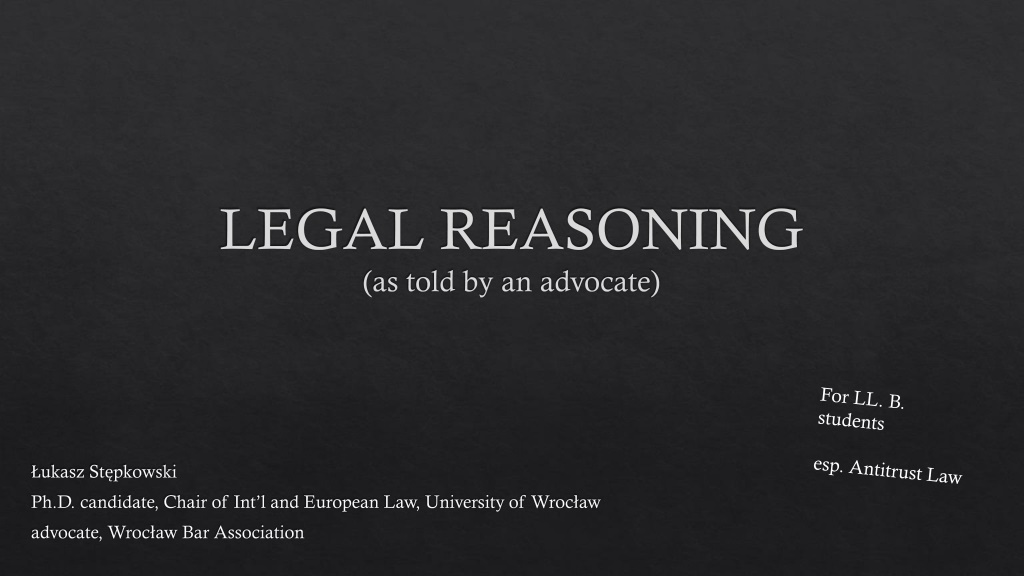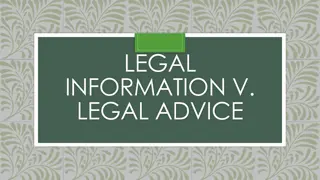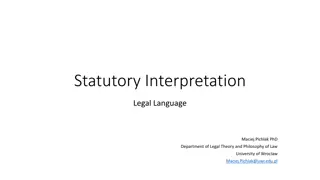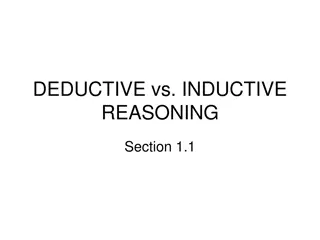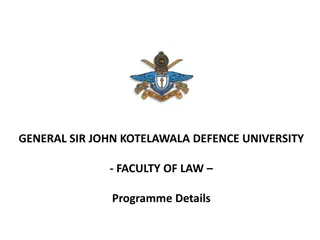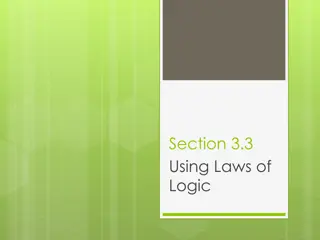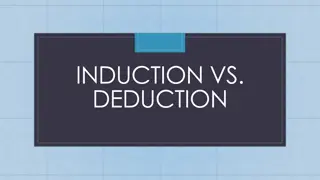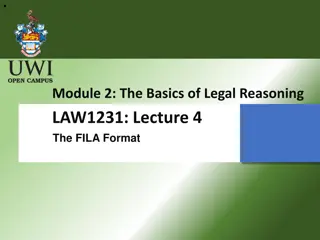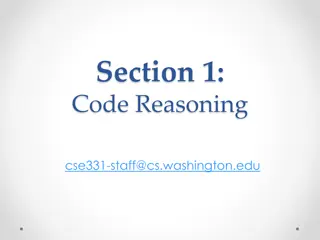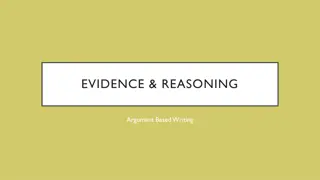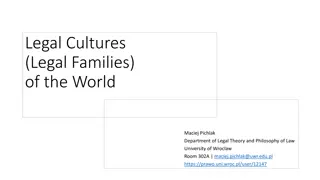Understanding Legal Reasoning: A Comprehensive Insight
Legal reasoning involves navigating through gaps, inconsistencies, and ambiguities in the law to interpret and apply legal norms effectively. This process of validation, interpretation, and application helps legal practitioners optimize the legal system and adapt it to real-life cases. The presentation delves into the intricacies of legal reasoning, providing a suggested approach, examples of solvable legal cases, and the importance of finding the relevant law to address legal questions.
Download Presentation

Please find below an Image/Link to download the presentation.
The content on the website is provided AS IS for your information and personal use only. It may not be sold, licensed, or shared on other websites without obtaining consent from the author. Download presentation by click this link. If you encounter any issues during the download, it is possible that the publisher has removed the file from their server.
E N D
Presentation Transcript
LEGAL REASONING (as told by an advocate) ukasz St pkowski Ph.D. candidate, Chair of Int l and European Law, University of Wroc aw advocate, Wroc aw Bar Association
The aim and purpose of this presentation To describe the notion of legal reasoning To outline the basics of a suggested, yet subjective approach to legal reasoning To provide ways of legal arguments able to be developed To discuss legal language and terminology used in legal reasoning ( Legalese is pejorative, use Legal English instead) To provide examples of solvable legal cases Not the only way to go about solving legal problems (for others, ask other lawyers, e.g. a prosecutor or a judge) Certainly, a way probably biased by an individual-centric view of a legal system, coupled with lingering undertones of legal positivism
The Notion of Legal Reasoning : the Why Any legal system is prone to gaps in law (lacunae), inefficiency, equivocal wording and inconsistency of its constitutive elements (e.g. different statutes, specific provisions thereof, case- law etc.) This is so because the law (usually) either follows the state of things or is introduced or amended to allow, amplify, limit or prohibit a certain issue; as such, any legal system is necessarily dynamic and incomplete However, when dealing with a set of facts and legal questions related to them, a practitioner has recourse only to the current state of the law; therefore, one has to live with the imperfection To allay the imperfection, one has to engage in an exercise in optimalisation of the system; to find the relevant law and interpret it as faithfully as possible to reflect the meaning of a legal norm The activity of establishing the existence of a legal norm is called validation The activity of establishing the contents of a legal norm is called interpretation or exegesis
The Notion of Legal Reasoning : the Why In the rare instance the law is clear as to its existence and contents (so there is no or little need of optimalisation), one still has to adapt the law to the facts of the case This is so because the law usually is abstract and general in its nature The activity of distilling a concrete and individualised norm of the law for the purposes of a given case and its legal repercussions is called application Application is ordinarily carried out by a competent authority (for instance, a national court) where some sort of legal proceedings is underway Sometimes, the application of law is either left to the parties (e.g. private law of contracts) or to a non-public body (e.g. during Alternative Dispute Resolution [ADR], incl. mediation, arbitration etc.) However, the bread and butter of a legal practitioner is the act of petitioning the competent authority to apply the law as suggested by said practitioner the act of invocation , preceding the application of the law
The Notion of Legal Reasoning : the What Henceforth, legal reasoning carried out by a practitioner is the proces of persuasion that comprises validation, interpretation and invocation of a certain legal norm (or norms) directed at the competent authority, in order to have the law applied in a certain way The aforementioned certain way usually involves taking account of the wishes of the client and always acting in her, his or their best interest However, an advocate may never knowingly lie to the competent authority In addition, there are certain ways and techniques in which this argument may be laid out
Approach to Legal Reasoning : the How The context of legal proceedings is a formal environment; therefore, the employed reasoning should use strictly formal language and proper form This is doubly true due to the fact that legal reasoning uses the language of the law and that of the legal doctrine, i.e. an official and highly technical, specific language In the English language, this would amount to Legal English Legal English traditionally uses certain Latin phrases to denote certain legal concepts and principles (Legal Latin) Furthermore, even in civil law jurisdictions where case law is not a formal source of law, judicial authorities are commonly used for their persuasive value
Approach to Legal Reasoning : the How Formal language requires that : Full wording should be used no abbreviations and familiarisms (Let us instead of Let s, going to instead of gonna) Attention should be paid to grammar an error does no credit to the writer The style should be clear and concise; while it is recommended to use a variety of tenses (e.g. Present/Past/Future Perfect, Continuous) this ought not to be used without purpose Proper meaning should be used : Legal English has specific expressions that differ in meaning from their counterparts in the ordinary language (quotidian words) Respect is to be shown to the authorities; temperance should be observed in both spoken and written pleadings
Approach to Legal Reasoning : the How Legal English contains a multitude of words that are specific to legal discourse Claim, claim form : an inquiry based on the law that a competent authority acted in a certain way, e.g. to grant relief; formal document initiating civil proceedings Bill of indictment : a formal document containing a claim accusing a person of an offence Interim measures/interim relief : a remedy issued by a competent authority (usu. a court) to regulate rights and duties of the parties in the course of legal proceedings Parties/a party : an individual to whose rights and duties the proceedings are relevant; esp. in adversarial proceedings Adversarial proceedings : syn. proceedings inter partes; proceedings in which the parties are equal; it is incumbent on them to present arguments and provide evidence; the competent authority in principle takes no initiative on its own Inquisitorial proceedings : the contrary to adversarial proceedings; proceedings where the authority takes an active role and is not constrained by the positions of the parties
Approach to Legal Reasoning : the How Claimant : one who lodges a claim Appellant : one who appeals from a decision of a court (i.e. claims in law that a certain decision of a court is wrong and should be set aside) Defendant : one who defends (i.e. resists) a claim (esp. in criminal proceedings) Respondent : one who resists against an appeal; one who defends a claim in equity Motion : an activity of petitioning the authority for a certain effect (in proceedings) To adjudicate : to decide a case; to rule on a claim Intervention / an intervener : a claim of a third party against one or more parties during proceedings; a person lodging an intervention Counsel, Legal Counsel : a professional lawyer Right of audience : the power to appear in court on behalf of someone (of legal practitioners)
Approach to Legal Reasoning : the How Legal Latin phrases often appear in legal reasoning Ex officio : on the authority s own motion Fumus boni iuris : the possibility of success on merits in a given case Lex retro non agit : the law does not act in retrospect Lex benignor/mitior retro agit : [Criminal law] the law acts in retrospect if it is more beneficial to the accused Prima facie : at first sight Inter alia : among others / among other things Mutatis mutandis : with necessary changes Inaudita altera parte : with either of the parties heard De minimis [non curat praetor] : of lesser issues [the court does not decide]
Approach to Legal Reasoning : the How A contrario : on the contrary A communi observantia non est recedendum : a common practice should not be abandoned A fortiori : therefore; from the same logic A limine : from the beginning A quo : from which Ab initio : from the beginning Actio popularis : a lawsuit brought on behalf of the community and not specifically on behalf of the claimant Res iudicata : the quality of being final and binding (esp. of judicial decisions) Lis pendens : (of a legal case) pending judgment, currently in proces Ad hoc : Solely for the purposes of a given case Amicus curiae : a nonparty lodging a submission In statu quo ante : in the former state quantum : quantity ( to a quantum ) verbatim : literally, exactly
Approach to Legal Reasoning : the How Legal writing makes use of several cryptic abbreviations e.g. : exempli gratia : for instance, for example i.e. : id est : that is cf. : compare viz. : videlicet : that is to say, namely ff. : and onwards, and the following pages infra : within (a paragraph or a specific part of the text) supra : above (a paragraph or a specific part of the text) pp. : pages (followed by a number; pp. 154-156 means pages 154 to 156) usu. : usually esp. : especially
Approach to Legal Reasoning : the How Legal reasoning should adopt a structure of the argument to be undertaken There are several ways to do this; however, the approach advocated herein is the claim- based or thesis-based way of drafting First, identify an issue (i.e. the legal question at hand) Second, validate a legal norm Third, interpret the norm Fourth, invoke the norm to be applied in a certain way You may either provide a thesis (or a claim) at the beginning of your submission, or enclose a skeleton argument summarizing your position (you may do both)
Approach to Legal Reasoning : the How In structuring your submission, you should try to convince the reader that your suggestions are reasonable This may be done through recourse to types of legal interpretation and legal inferences There are three principal types of legal interpretation of a norm Textual interpretation (text of a legal act is important) Systematic interpretation (a legal system is important) Teleological interpretation (the purpose of a norm is important) Legal inferences are the activities of either deducing or inducing a norm from other norms of law Argumentum a maiore ad minus : from greater to lesser : if A is allowed, then B which is less than A should also be allowed Argumentum a minore ad maius : from lesser to greater : if B is prohibited, then A which is more damaging than B should also be prohibited Argumentum a simili : similarity : if A and B are alike, B should be treated like A and vice versa
Approach to Legal Reasoning : the How Apart from legal arguments and inferences, a practitioner may (and should) use jurisprudence (case law or judicial authorities) and legal doctrine to provide additional force to one s reasoning Case law should be relevant; irrelevant authorities are likely to impair their persuasive character Proper citation should be used (refer to a particular legal system) In EU law, the ECLI citation and the CELEX numbering system are present on the EUR- LEX website (example : ECLI:EU:C:2015:655 and CELEX number 62014CJ0061 may be used to arrive at the same decision of the GC; however, the CJEU itself uses the ECLI citation) Legal doctrince refers to academic works on the subject at hand; if a discrepancy in law is found in the academia, it is usual that someone publishes a paper on it either criticising it or suggesting an amendment Legal works may be cited e.g. as J. Doe, Title, Place of Publication, Year of Publication, p. (or pp.) where a relevant item appears
Approach to Legal Reasoning : EU Law Legal reasoning within the context of the law of the European Union has several additional elements to the generic model One should, immediately after validation, justify why EU law would be relevant in a given case, to avoid the purely internal situation The need to use jurisprudence is amplified due to the fact that EU law is greatly influenced by case law of the CJEU The teleological interpretation is favoured Expressions used in EU law should be interpreted rather by recourse to EU law alone (autonomous concepts in EU law), unless there is reference to national law
Approach to Legal Reasoning : EU Law There are, apart from the general model, specific legal phrases used in the context of legal reasoning in regard to EU law direct action : a legal claim of an individual founded directly on the Treaties (e.g. on 263 TFEU), heard by EU Courts preliminary ruling : a decision of the CJ handed down under 267 TFEU direct effect : capability of being invoked for the purposes of application (of a norm of EU law), also a principle primacy : quality of a binding norm of EU law to, inter alia, require a competent authority to disapply the conflicting norm of national law in a given case, if no means of interpretation lead to the interpretation in conformity with EU law, also a principle harmonious interpretation : the requirement that national law should be interpreted in conformity with EU law, also a principle
Case-solving : Example I Facts of the case A national competition authority is investigating a possible cartel of lift producers. Several of those producers are based in different Member States of the European Union. It is alleged that these lift producers set prices after joint meetings. No formal document has ever been adopted by the concerned producers. Exercise It is required to draw up a legal opinion whether such conduct is prohibited and if so, what should be done.
Case-solving : Example I continued Identify the issue : the possible existence of a prohibition, required course of conduct Step I : find relevant law (validation) > Article 101(1) TFEU Step Ia : justify why EU law would be important : note that competition law of the Union is an area of exclusive competence (ex Article 3 TFEU), and as such, is applicable in general in the field of competition note that there is an European dimension to the case due to the fact that producers operate in a cross- border manner Step II : interpret the law > refer to the notion of concerted practices under 101(1) TFEU, cite jurisprudence Step III : apply the law to the facts > note that it is the national competition authority that acts; assess that the conduct falls within the ambit of concerted practices and resale price maintenance (art. 101(1)(a) TFEU) and is therefore prohibited; refer to Reg. 1/2003 on powers of NCAs; suggest a solution (e.g. setting of a fine) Summarize your findings
Case-solving : Example II (D.I.Y.) A national court is considering a case where there is an infringment of EU law in the form of Article 101 TFEU by two undertakings active in the field of shipbuilding, though market control. The European Commission has issued a decision requiring those undertakings to stop; the decision has not been challenged. The national court hands down a ruling that becomes final, allowing the undertakings to continue as normal. Draw up a legal opinion assessing whether the conduct of a national court is in line with EU law; if not, analyze the effect of such a ruling.
